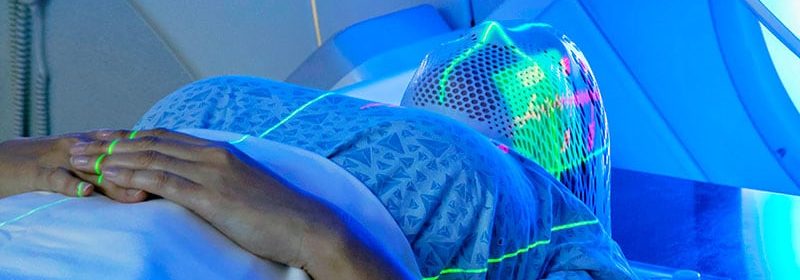Radiation Approach Improves Swallowing in Head, Neck Cancer

Dysphagia — trouble swallowing — is one of the most common side effects of radiation for head and neck cancer and can be so bad that patients require a permanent gastrostomy tube for feeding.
A team of British investigators are now reporting a new strategy to help lessen this problem.
In the trial, the approach — dubbed dysphagia-optimized intensity-modulated radiotherapy (DO-IMRT) — reduced incidental radiation to the pharyngeal constrictor muscles responsible for swallowing during IMRT for pharyngeal cancer. Patients randomized to DO-IMRT reported significant improvements in swallowing at 1 year compared with those receiving standard IMRT, at no cost to oncologic outcomes.
Overall, the findings show “DO-IMRT improves patient-reported swallowing function compared with standard IMRT,” said investigators led by Christopher Nutting, MD, PhD, a head and neck cancer specialist at the Royal Marsden Hospital, London. “DO-IMRT should be considered a new standard of care.”
The team reported the results of their phase 3 trial July 6 in The Lancet Oncology.
Swallowing issues affect most patients with head and neck cancer after radiation therapy but strategies to mitigate this long-term adverse effect remain limited.
Nutting and colleagues wanted to assess whether a novel approach to radiation therapy could reduce the swallowing problems patients often encounter.
In the trial, 112 subjects with T1-4, N0-3, M0 oropharyngeal (90%) or hypopharyngeal cancer (10%) were randomized to standard IMRT or DO-IMRT. Patients received care at 22 radiation therapy centers in Ireland and the UK from 2016 to 2018.
Patients got radiation in 30 fractions over 6 weeks; most also had chemotherapy. The standard IMRT group received 65 Gy to their primary and nodal tumors and 54 Gy to other pharyngeal and nodal areas. In the DO-IMRT group, radiation doses to pharyngeal constrictor muscles lying outside of the tumor target area were limited to 50 Gy.
At 1 year, 56 patients randomized to DO-IMRT scored, on average, 7.2 points higher than the 56 patients randomized to standard IMRT — 77.7 points vs 70.6 (P = .037) — on the 100-point MD Anderson Dysphagia Inventory (MDADI). MDADI is a validated scale for tracking radiation-induced dysphagia, with higher scores indicating better swallowing function.
The difference grew to 9.8 points when adjusted for chemotherapy use and tumor location and stage.
DO-IMRT patients were also more likely to report eating their normal diet and dining in public. Speech and language therapists who, like patients, were blinded to treatment allocation, reported better outcomes among patients receiving DO-IMRT as well.
At just over 3 years, oncologic outcomes were essentially equivalent in both groups. Two local recurrences occurred in both arms; distant metastatic recurrences occurred in three patients in the DO-IMRT group and two in the standard IMRT group.
The most common grade 3-4 late adverse events were hearing impairment (16% with DO-IMRT vs 13% with standard IMRT), dry mouth (5% vs 15%), and dysphagia (5% vs 15%).
Taken together, the findings indicate that reducing doses to the pharyngeal constrictor muscle translates to “a meaningful benefit for patients” in terms of improved swallowing function, the investigators said.
In an accompanying editorial, Sandra Nuyts, MD, PhD, noted, however, that the trial failed to meet the predefined threshold for clinical significance, a 10-point difference in MDADI scores.
Still, “several other patient-reported and physician-reported secondary endpoints favored DO-IMRT,” explained Nuyts, a radiation oncologist at the Leuven Cancer Institute, Belgium. Considered alongside positive reports from smaller, nonrandomized studies, “there is now compelling evidence that the risk of dysphagia after head and neck radiotherapy can be reduced with this technology, without increasing the risk of local recurrences.”
The study team and Nuyts both called for further refinement of the technique, particularly figuring out what specific sections of the constrictor muscles need to be spared to optimize outcomes.
For now, there is a limit on “how much organ sparing can be achieved with the current DO-IMRT technique” because “use of even narrower margins” around the tumor runs the risk of not treating it adequately, investigators said.
The study was funded by Cancer Research UK. Nutting reports stock options in Advanced Oncotherapy. Another investigator reports institutional grants from Varian, AstraZeneca, Roche, and other companies. Nuyts reports no relevant financial relationships.
Lancet Onc. Published online July 6. Full text; editorial.
M. Alexander Otto is a physician assistant with a master’s degree in medical science and a journalism degree from Newhouse. He is an award-winning medical journalist who worked for several major news outlets before joining Medscape. Alex is also an MIT Knight Science Journalism fellow. Email: [email protected]
For more from Medscape Oncology, join us on Twitter and Facebook.
Source: Read Full Article